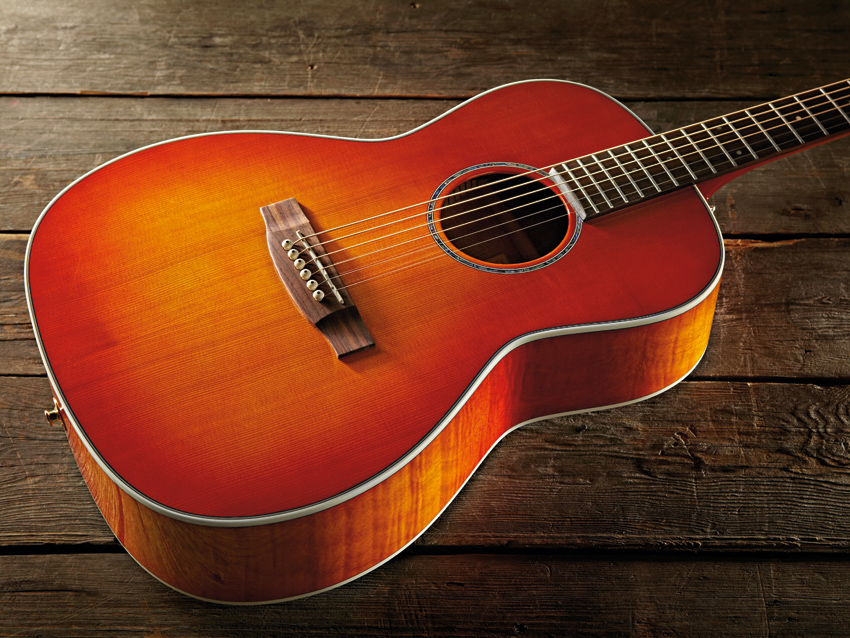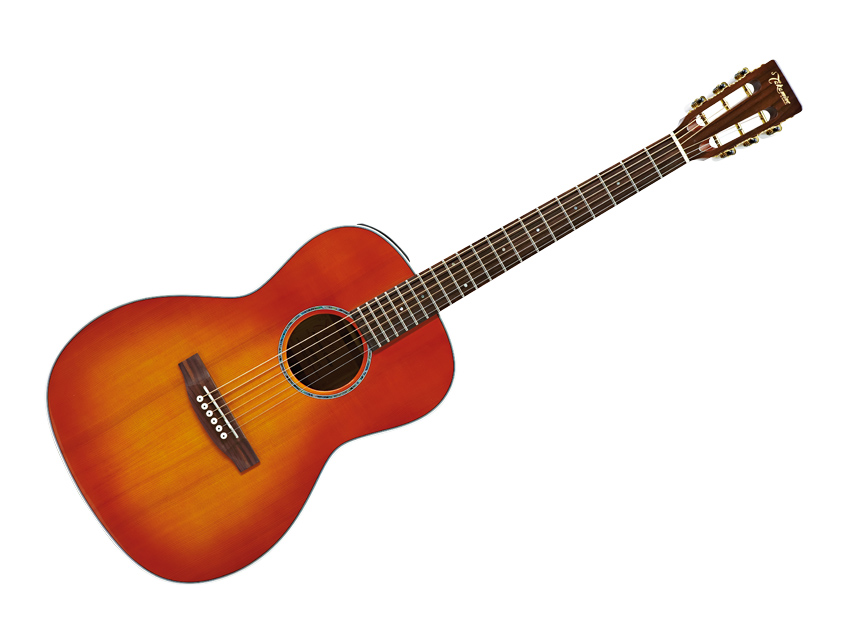MusicRadar Verdict
Attractive parlour style offers plenty of personality as an electro.
Pros
- +
Classy presentation; very good powered sounds.
Cons
- -
Rather thin acoustic tones; the non-muting tuner.
MusicRadar's got your back

Takamine EG630S-VV

Takamine EG630S-VV

Takamine EG630S-VV
Takamine's New Yorker body style - inspired by Martin's 00 design of the late 19th century - first appeared in 1995 as the PSF-95, a Santa Fe limited edition.
This was adapted as a regular model the following year as the FP317S, and revived in 2000 under the EF317S moniker, along with a slot-head variant, the EF407. New Yorkers have never figured heavily in the Takamine catalogue, but the EF407 is ongoing and has been joined over the last couple of years by four more affordable G/EG-Series versions, including our EG630S-VV.
"Powered up, the sound is that of a much larger-bodied and more dynamic guitar."
Though carrying a slot headstock, the EG630S-VV is an otherwise modern take on the 14-inch-wide 00 design: as on all New Yorkers to date, it has a neck that joins the body at the 14th, not 12th, fret. The guitar, resplendent in an ambery, all-gloss 'vintage violin' finish with a subtly bursted top, uses a solid spruce top - slightly wavily grained here but not unattractive - and back and sides stated as flame maple.
The handsomely figured and bookmatched outer veneers certainly are, but the inner plys are mahogany or similar. At the price, this is hardly surprising because figured maple isn't cheap these days, and even using all-maple laminates would likely have bumped the cost up.
Cosmetic adornments are tastefully simple, largely letting the lacquer livery convey the sense of plushness. The body is bound in black-coachlined white plastic with multi-ply purfling around the top and a thin white centre line down the back.
The rosette is a simple abalone-inlaid ring; the position markers on the bound rosewood fingerboard are conventional pearl dots. White pearloid buttons on the gold-plated Spanish-style tuners mirror the colour of the body binding, while the peghead is faced with rosewood. Lastly,
a practical detail that's always good to see is a stage-ready strap button at the heel.
The 644mm-scale neck - three-piece mahogany with scarfed headstock and separate heel - is an aspect of the instrument upon which Takamine seems to be slightly hedging its bets. In span and string spacing it conforms to the company's typical slender template - respectively 43mm across the nut and 53.5mm spacing at the bridge - yet the 'C' profile is relatively full: over 24mm deep as it approaches the heel turn.
This is by no means overly bulky - in fact with our sample's slinky action and well-dressed fretting we found it to be fast and slick. But one wonders whether some players would prefer either a shallower profile given the mainstream width, or a more vintage-like fingerstyle affair. This one attempts a bit of both.
Powering is provided by Takamine's familiar TP-4T system, providing slider-based three-band EQ, a nice large volume knob and an auto-chromatic tuner, which annoyingly doesn't mute the system when activated. The only handling drawback, as with all Takamine rim-mount preamps, is that the shoulder positioning gives a very oblique view of the control plate.
Sounds
The guitar's back and sides may not be all-maple, but the acoustic sound is somewhat redolent of that timber. The tone is quite bright and taut with a modest low end, and even allowing for the body size it's not exactly a punchy or warm 00.
However, an upside is a very even response across the strings, something that's invariably a maple benefit. With the EQ set flat, these tonal traits are replicated when powered up, but the system offers plenty of scope to enrich things.
A touch of bass boost, ease off some treble, maybe ditto the mids, and the result is the sound of a much larger-bodied and more dynamic guitar. The preamp is impressively gainful too.
Not everyone wants a parlour to be a full-blown vintage reworking, and this Takamine ably fulfils a modern-day interpretation with a touch of retro thrown in. The unplugged sound doesn't exactly set the world alight, but its admirable capabilities as an electro easily compensate - and it's a fine looker too.
“A synthesizer that is both easy to use and fun to play whilst maintaining a decent degree of programming depth and flexibility”: PWM Mantis review
“I feel like that song had everything we needed to come back with”: Bring Me The Horizon’s Lee Malia on Shadow Moses, its riff and the secrets behind its tone, and why it was the right anthem at the right time
“I said, ‘Are we sure we can write a song about death?’”: The story of Mike + The Mechanics' classic No.1 The Living Years









